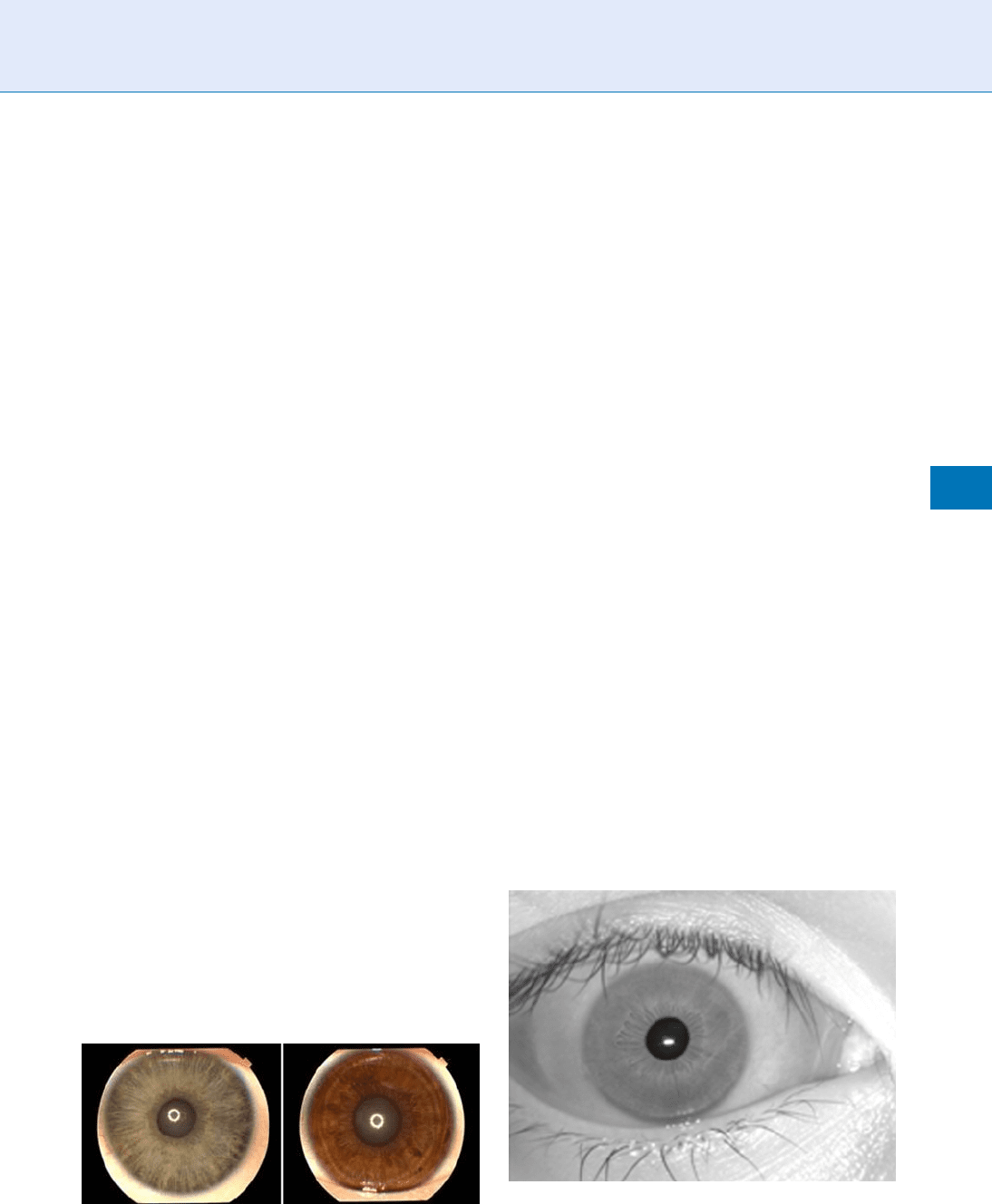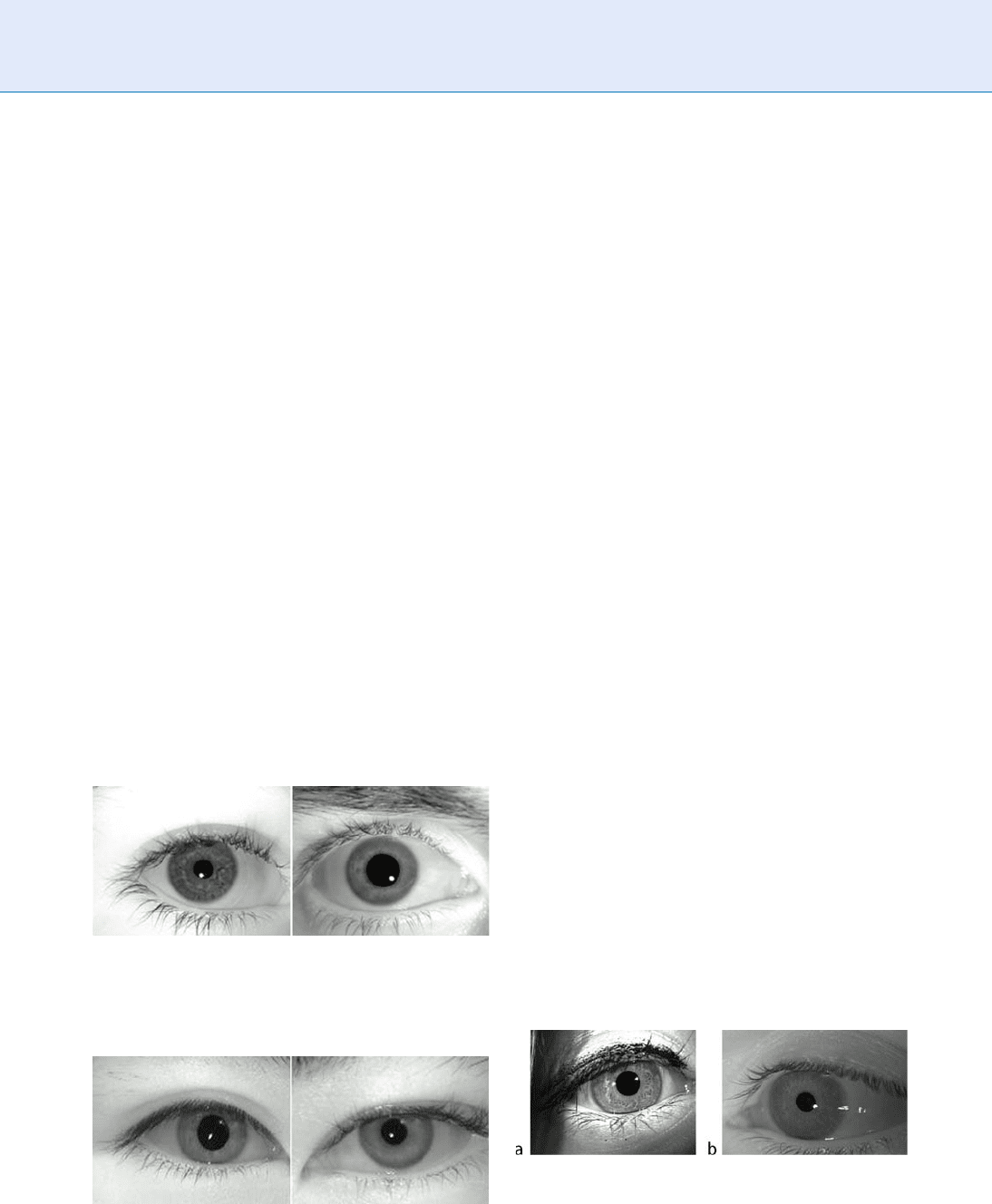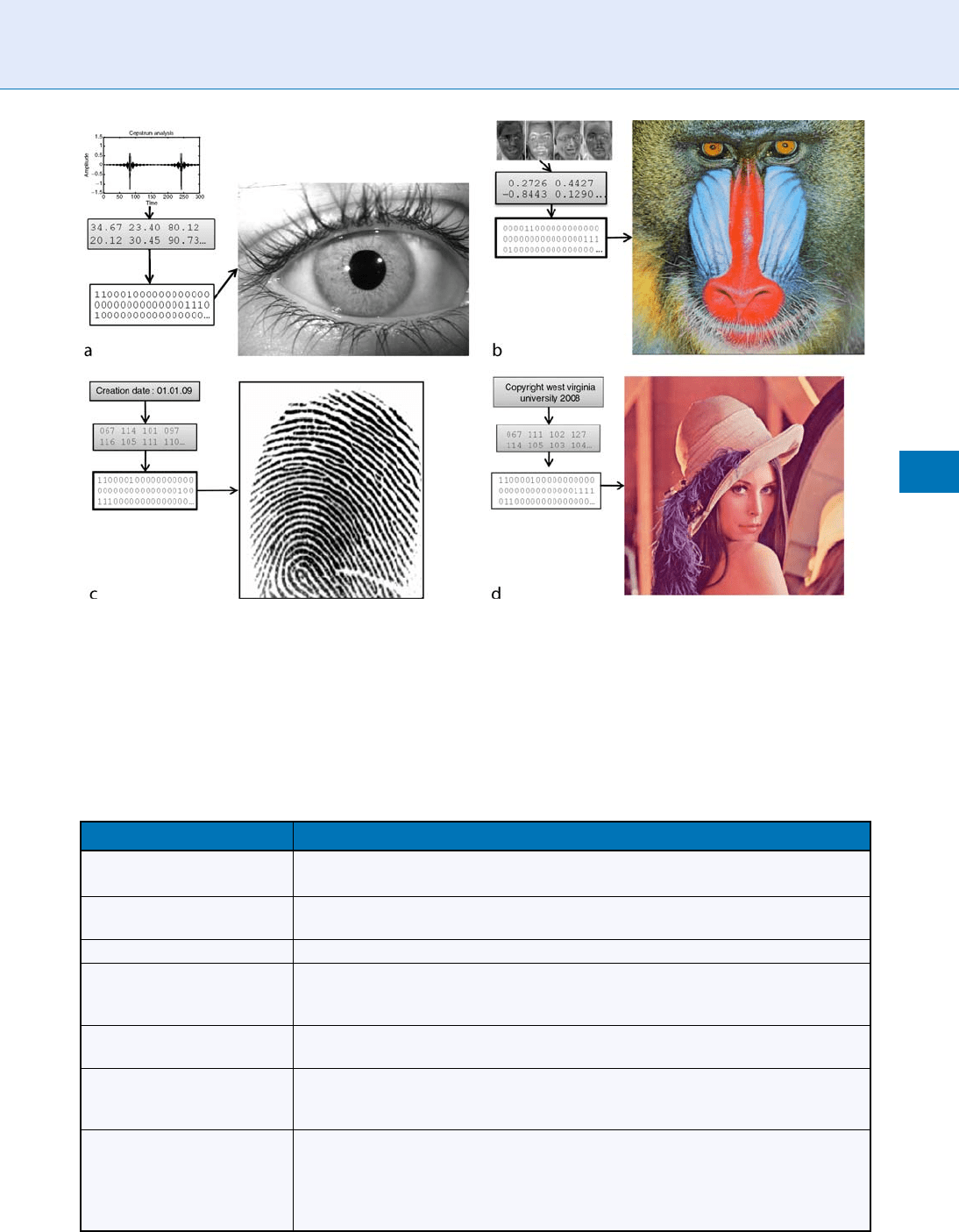Li S.Z., Jain A.K. (eds.) Encyclopedia of Biometrics
Подождите немного. Документ загружается.


Iris Capture
▶ Biometric Sample Acquisition
Iris Data Interchange Standards
▶ Iris Image Data Interchange Formats ,
Standardization
Iris Databases
DAM ON L. WOODAR D
1
,KARL RICANEK
2
1
Clemson University, Clemson, SC, USA
2
University of North Carolina Wilmington,
Wilmington, NC, USA
Definition
An iris database is a collection of images that contain,
at a minimum, the iris region of the eye. The images
are typically collected by sensors that op erate in
the
▶ visible spectrum, 380–750 nm, or the near infra-
red spectrum (NIR), 700–900 nm. The visible spec-
trum image can be stored as a color image or as an
intensity image. The NIR image is always stored as an
intensity image.
Introduction
Successful biometric research requires the analysis of
human data. For biometric researchers to demonstrate
the effectiveness of proposed iris segmentation/
recognition techniques and allow fair comparisons
with existing methods, publicly available iris databases
are required. The perfect iris-image database should be
sufficiently large, consist of images collected from a
large and heterogeneous group of subjects, and contain
images that depict noise factors typically encountered
in real world applications. In the following sections,
several publicly and freely available iris-image data-
bases are described.
CASIA V1.0, V2.0, IrisV3 Databases
The CASIA Iris Image databases were collected by the
Institute of Automation at the Chinese Academy of
Sciences. The original CASIA database (CASIA V1.0)
is one of the oldest publicly available systems for eval-
uation of the iris biometric modality; hence, CASIA
V1.0 has been widely used for research and evaluation.
The database [1] consists of 756 320 280 intensity
iris images of 108 eyes captured using a sensor devel-
oped in-house. The images are stored as 8 bit gray-level
JPEG files. Seven images are captured from each eye
during two sessions, three during the first session and
four during the second. The data acquisition environ-
ment was hig hly constrained which limited the noise
types present in the image to iris occlusion from eye-
lids and eye lashes. It was determined that the iris
images of the CASIA V1.0 database had been photo-
graphically edited by replacing the pupil region with a
circular region of uniform intensity [2], which is illu-
strated in Fig. 1. Therefore, this version of CASIA
should not be used for algorithm development or
evaluation.
The CASIA V2.0 database was released later and
contains 2,400 images collected from 60 eyes. Twenty
images per eye were collected using two different sen-
sors, the in-house sensor and the OKI Iris Pass system.
In order to receive copy of CASIA V2.0, CASIA V1.0
must be downloaded first.
The CASIA-IrisV3 datab ase consists of 22,051
images captured from 1,500 eyes of more than 700
subjects, organized three separate databases of dis-
joint subject groups [3]. The ‘‘Interval’’ subset contains
2,655 images captured from 396 eyes of 249 subjects.
The 320 280 intensity images were captured indoors
using a self-developed sensor that was used in CASIA
V1.0 during two acquisition sessions over at least a
Iris Databases. Figure 1 Example images from CASIA
V1.0 and CASIA-IrisV3 ‘‘Interval’’ databases. (a) An image
from CASIA v1.0 (b) An image from CASIA-IrisV3.
770
I
Iris Capture

1 month time. Included in the ‘‘Interval’’ database is an
unedited – the pupil region was not replaced to mask
the NIR illumination pattern – sup erset of the CASIA
V1.0 database. An example of the unedited image can
be found in Fig. 1(b).
The ‘‘Lamp’’ database contains 16,213 images cap-
tured from 819 eyes of 411 subjects. The 640 480
grayscale images were captured indoors with varying
illumination with the OKI IRISPASS-h sensor during a
single acquisition session. The ‘‘Twins’’ database con-
tains 3,183 imag es captured from 400 eyes of 200
subjects. The 640 480 intensity images were captured
outdoors using the OKI IRI SPASS-h sensor during a
single acquisition session.
UPOL Database
The UP OL iris-image database was constructed at the
University of Palacke
´
ho and Olomouc in the Czech
Republic [4, 5]. The database contains 384 768 576
color images captured from 128 eyes of 64 subjects
(three images per left and right eye). The images are
stored as 24-bit color images in the PNG image format.
Unlike the other iris-image databases, the UPOL data-
base was acquired using an optometric sensor (TOP-
CON TRC50IA optical device connected to a SONY
DXC-950P camera). As a result, the images are of
very high quality and are practically noiseless, as
shown in Fig. 2.
BATH Database
The University of Bath, UK, iris-image database is
composed mainly of images captured from its ethni-
cally diverse staff and students [6]. The database
contains over 16,000 1280 960 iris images collected
from each eye of 800 subjects. A commercial version of
this database claims to be twice as large. The sensor
used for data collection was the ISG LightWise LW-1.3-
S-1394. Illumination was provided using an array of
infrared LEDs positioned such that reflections were
confined to the pupil area w ithin the image, which is
illustrated in Fig. 2. An infrared pass filter was used to
reduce environmental light reflections. The researchers
were able to achieve high qualit y images using this
framework. The main sources of noise within the
images are due to the occlusion of the iris by eyelids
and eye lashes (Fig. 3).
ICE2005 and ICE2006 Databases
The Iris Challenge Evaluation (ICE) was conducted and
managed by the National Institute of Standards and
Technology (NIST) and consisted of an iris recognition
challenge problem distributed to various participating
universities, government agencies, and biometric tech-
nology companies [7]. The broad goals of ICE were
to facilitate the development of iris recognition tech-
nology along with assessing the state of iris recognition
systems.
The ICE2005 database consists of 2,953 640 480
intensity images with varying numbers of images ac-
quired from each subject [8]. The images are 8-bit gray-
level in the TIFF image format. Exactly 1,425 images
Iris Databases. Figure 2 Example images from UPOL iris
image database.
Iris Databases. Figure 3 Image from the Bath iris-image
database demonstrating the illumination array centered
in the pupil [6].
Iris Databases
I
771
I

were captured from the right eye of 124 subjects and
1,528 images were captured from the left eye of 120
subjects. Images of both eyes of 112 subjects were
collected resulting in 132 total subjects used to con-
struct the database. Images were collected using an LG
Iris Access 2200 iris camera. There are representations
of various types of image noise within the database
such as iris occlusion, poor focus, and partially cap-
tured eyes as illu strated in Fig. 4. A larger databas e of
over 65,000 images captured from 356 subjects in
planned for release. The new database is a superset of
the ICE2005 database and the later constructed
ICE2006 database.
MMU1 and MMU2 Databases
The Multimedia University constructed a relatively
small data set of 450 320 240 grayscale iris images
designated as MMU1 [9]. These images were captured
using the LG IrisAccess 2200 camera. Examples images
are shown in Fig. 5. Information regarding the number
of eyes and subjects used to construct this database is
not provided.
A new database of 995 iris images captured from
100 subjects from Asia, Middle East, Africa, and
Europe, using the Panasonic BM-ET100US Authenti-
cam. Five images were taken from each of the subjects’
eyes. Five left eye images were discarded due to a
subject’s diagnosis of cataract disease. As with many
of the previous databases, noise present in the images
was mainly due to iris occlusion.
WVU Non-Ideal Iris and Off Axis/Angle
Databases
The West Virginia University constructed two iris-
image databases [10, 11]. The iris portion of the data-
base consists of 3,099 480 640 grayscale iris images
captured from 244 subjects. The images were captured
during a single session using the OKI IrisPass-H sen-
sor. The number of images from each eye varies
between three and six. This database was constructed
as a non-ideal iris-image database, and therefore, con-
tains a considerable number of images that depict
various types of noise, which could be encountered
in a real world scenario. Noise types include iris occlu-
sions, varying illumination, poor focus, and off-angled
images. An example image from this database is shown
in Fig. 6(a).
Most iris databases are composed of frontal view
iris images. The second WVU iris database is com-
posed of images of irises taken at various angles. The
database was captured using two sensors. The first set
of images was captured using the Sony Cyber Shot
DSC F717 camera used in infrared mode. There are
268 2560 1920 RGB images captured from 19 sub-
jects during a single acquisition session. During data
collection the camera was positioned at the angles of
0, 15, and 30 degrees. The second set of images for this
database was captured using a monochrome camera.
Iris Databases. Figure 4 Example images from ICE iris
database.
Iris Databases. Figure 5 Example images from MMU1 iris
database.
Iris Databases. Figure 6 Example images from WVU
non-ideal iris image and off-axis/angle iris image
databases. (a) Non-ideal iris image example (b) Off-angle
iris image example.
772
I
Iris Databases

There are 597 720 480 intensity images captured
from 73 subjects during a single acquisition session.
As with the other image set, the camera was positioned
at the angles of 0, 15, and 30 degrees during data
collection. An example iris image captured at 15
degrees off-angle is shown in Fig. 6(b).
UBIRIS.v1 and UBIRIS.v2 Database
In order for researchers to test the robustness of
iris segment ation/recognition algorithms when using
noisy images, University of Beira Interior constructed
an iris database of noisy iris images [12, 13]. The
images were captured using the Nikon E5700 camera.
There are 1,877 2560 1704 RGB images captured
from 241 subjects during two acquisition sessions. To
introduce noise to the process, the location of the
acquisition session was changed to facilitate changes
in natural luminosity, contrast, reflections, and focus,
as shown in Fig. 7.
Recently, the University of Beira Interior made
available a second version of the UBIRIS database,
UBIRIS.v2, which currently consists of 11,000 images
and is only available to participants in the
▶ Noisy Iris
Challenge Evaluation (NICE) Part I contest [14].
Summary
Iris-image databases are crucial to the development
and advancement of iris-based biometrics . These data-
bases along with prescribed evaluation methodologies
allows for direct comparison of iris segmentation/rec-
ognition algorithm performance. The databases will
increase in size and complexity of iris-image until all
algorithmic problems, inefficiencies, and shortcomings
have been fully addressed.
Related Entries
▶ Iris
▶ Iris Acquisition Device
▶ Iris Challenge Evaluation
▶ Iris Image Quality
▶ Iris Sample Synthesis
Bibliography
1. Institute of Automation, Chinese Academy of Science: CASIA
v1.0 Iris Image Database, 2008. http://www.nlpr.ia.ac.cn/english/
irds/irisdatabase.htm. Accessed 27 Dec, 2008
2. Phillips, P.J., Bowyer, K.W., Flynn, P.J.: Comment on the CASIA
version 1.0 Iris Dataset, IEEE Trans. Pattern Anal. Mach. Intell.
29(10), 1869-1870 (2007)
3. Institute of Automation, Chinese Academy of Science: CASIA
v3.0 Iris Image Database, 2008. http://www.nlpr.ia.ac.cn/english/
irds/irisdatabase.htm. Accessed 27 Dec, 2008
4. Dobes
ˇ
, M., Machala, L.: UPOL Iris Image Database, 2008. http://
phoenix.inf.upol.cz/iris/. Accessed 27 Dec, 2008
5. Dobes
ˇ
, M., Machala, L., Tichavsky
´
, P., Pospı
´
s
ˇ
il J.: Human Eye Iris
Recognition Using the Mutual Information. Optik 115(9),
399–405 (2004)
6. University of Bath: University of Bath Iris Image Database, 2008.
http://www.bath.ac.uk/eleceng/research/sipg/irisweb/index.html.
Accessed 27 Dec, 2008
7. National Institute of Standards and Technology: Iris Challenge
Evaluation (ICE), 2008. http://iris.nist.gov/ICE/. Accessed 27
Dec, 2008
8. Liu, X., Bowyer, K.W., Flynn, P.J.: Iris Recognition and Verifica-
tion Experiments with Improved Segmentation Method. In Pro-
ceedings of Fourth IEEE Workshop on Automatic Identification
Advanced Technologies (AutoID). Buffalo, NY, 17–18 October
2005
9. Multimedia University: MMU1 and MMU2 Iris Image Data-
bases, 2008. http://pesona.mmu.edu.my/~ccteo. Accessed 27
Dec, 2008
10. West Virginia University: West Virginia University Biometric
Dataset Collections, 2008. http://www.csee.wvu.edu/~simonac/
CITeR_DB. Accessed 27 Dec, 2008
11. Ross, A., Crihalmeanu, S., Hornak, L., Schuckers, S.: A Centra-
lized Web-Enabled Multimodal Biometric Database. In Proceed-
ings of the 2004 Biometric Consortium Conference (BCC),
Arlington, VA, September 2004
12. Proenc¸a, H., Alexandre, L.: UBIRIS: A Noisy Iris Image
Database. In: Proceedings of the 13th International Conference
on Image Analysis and Processing (ICIA2005), Vol. 1, pp. 970–
977, 2005
13. SOCIA Lab – University of Beira Interior: UBIRIS.v1 Iris Image
Database, 2008. http://iris.di.ubi.pt/ubiris1.html. Accessed 27
Dec, 2008
14. SOCIA Lab – University of Beira Interior: Noisy Iris Challenge
Evaluation – Part I, 2008. http://nice1.di.ubi.pt/
Iris Databases. Figure 7 Example images from UBIRIS.v1
iris database [12].
Iris Databases
I
773
I

Iris Device
JAMES R. MATEY
Electrical and Computer Engineering Department,
US Naval Academy, Annapolis, MD, USA
Synonyms
Iris camera; Iris image capture device; Iris reader; Iris
camera; Iris scan ner
Definition
An iris device is a device that acquires images of the iris
for use in biometric recognition. More commonly re-
ferred to as iris cameras, readers or scanners, these
devices typically include some form of active
▶ near
infrared illumination (NIR), since the current iris rec-
ognition algorithms were designed for NIR images of
the eye. In addition, the device may include features to
aid subjects in properly aligning their eyes in the field
of view, spoofing countermeasures, and on board pro-
cessing of the acquired images.
Introduction
Iris recognition is one of the strongest biometrics
available [1–4]. Iris recognition is a strong biometric
because: (1) the human iris is a complex structure with
a high degree of randomness; (2) the iris is protected;
(3) the iris is accessible; and (4) the structures of the
iris that are used for iris recognition are stable, from
early childhood on – in the absence of illness or injury
that disrupts the iris tissue.
The first mention of iris patterns as a biometric w as
likely a paper by Bertillon [5]; several others subse-
quently suggested iris patterns as a biometric and the
idea was a plot element in the 1983 James Bond film
Never Say Never Again [6]. However, it was not until
the early 1990’s that John Daugman developed a prac-
tical algorithm for iris recognition based on Gabor
wavelets [7]. Minor variants on the Daugman algo-
rithm remain the dominant algorithms in commercial
iris recognition systems as of 2008, though there are
vigorous research efforts into alternative algorithms
[8]. The commonly used name for the Daugman algo-
rithms in current use is
▶ iris2pi.
Further discussion of algorithms may be found in
other entries that cover the algorithmic aspects of iris
recognition in detail. This entry is concerned with
devices that can acquire images suitable for iris recog-
nition. The reader may well ask, ‘‘What is a suit able
image?’’ That question depends on the algorithms used
for recognition, and the determination of the mini-
mum quality image for a given application is still a
matter for research. However,
▶ ANSI and ▶ ISO have
published standards [9] for iris image quality that are
generally accepted for commercial applications. From
the standpoint of iris image capture device design, the
most impor tant of these image quality metrics are
▶
Resolution: 100–200 ▶ pixels across the iris
Signal to noise ratio: 40 dB, 100:1. For 8 bit pixels
exercised over the full dynamic range, the noise
would be 2 digita l numbers (DN). Equiva-
lently, 7 bits should be meaningful.
▶
Contrast: For 8 bit pixels, 90 gray levels of sepa-
ration between the iris and sclera and a 50 gray
levels of separation between iris and pupil
Operating ▶ wavelength: 700–900 nm
Brief History of Iris Image Acquisition
Devices
The first commercial iris image acquisition device was
the System 2000 from IrisScan [ 10] in 1995. In the past
decade numerous iris image acquisition devices have
been introduced, as can be seen from the partial listing
in Table 1. To the author’s knowledge, there has not yet
been a comprehensive, publicly available evaluation of
the relative merits of these devices. One of the most
comprehensive tests to date was conducted by the
International Biometrics Group (IBG) for the US
government. There have also been tests of iris recogni-
tion algorithms – rather than the acquisition devices –
such as the Iris Challenge Evaluation (ICE) competi-
tion sponsored by the NIST.
The IBG study compared one product each
from Panasonic, OKI and LG. A subsequent IBG
study [11] reported on the IrisGuard H100. The lack
of more comprehensive iris device evaluatio ns is
understandable. Iris recognition works quite well;
its failure rates are low. Hence, statistically significant
774
I
Iris Device

probes of the false match, false non-match, failure to
enroll and failure to acquire rates require many indi-
vidual trials, making such tests difficult and expensive.
The addition of evaluations of ease of use and suitabil-
ity for various scenarios only compounds the problem.
Another non-technical issue is also important: the
iris recognition marketplace is intensely competitive –
so much that some of the rivals have had protracted
legal battles in the courts. Under these conditions,
convincing a vendor to participate in a public test
whose results might show that their product is in
some way inferior to a competitor’s product can
be far more difficult than any technical challenge.
There have been unpublished evaluations of iris
devices by government and private industry – some
of which may be obtained by request to the device
manufacturers.
This entry will trace the operation of a generic
iris image acquisition device – from
▶ photons to
identity – and di scuss the metrics that are important
for evaluation of such devices in generic dep loyment
scenarios.
Photons to Iris Image
Iris recognition starts with photons of light from am-
bient illumination or from an active illuminator within
the iris recognition system. The photons impinge upon
the subject iris and are partially reflected. The reflected
photons fall into two categories, specular
▶ reflection
and diffuse reflection. The specular reflection is due to
the impedance mismatch between eye tissue and air;
the physics is the same as that for the reflections that
you see in a piece of otherwise clear window glass or a
bathroom mirror. Since the eye is curved, it acts as a
convex mirror and reduces the apparent size of objects
seen in its specular reflections (Some automobile rear
Iris Device. Table 1 Partial List of Iris Image Acquisition Devices
Vendor Model Year introduced
IrisScan System 2000 1995
OKI IrisPass
1
-S 1998
LG 2200 1999
Sensar R1 1999
Iridian Authenticam ™ 2000
Panasonic BM-ET-100 – Authenticam™ 2001
LG 3000 2002
OKI IrisPass
1
-WG 2002
Panasonic BM-ET-500 2002
IrisGuard H-100 2003
Securimetrics Pier™ 2.2 2003
Securimetrics Pier™ 2.3 2003
OKI IrisPass-H 2004
Panasonic BM-ET-300 2004
LG 4000 2005
OKI IrisPass
1
-M 2005
Sarnoff Corporation Iris On the Move™ 2005
Securimetrics HIIDE™ 2005
IriTech Neoris 2000 2006
Jiris JCP1000 2006
Panasonic BM-ET-330 2006
Hoyos Hbox™ 2007
Panasonic BM-ET-200 2007
IrisGuard AD-100 2008
Iris Device
I
775
I

view mirrors are convex and carr y the warning
‘‘Objects may be closer than they seem’’).
The diffusely reflected fraction is the
▶ albedo of
the iris and is of the order of 10% in the near infrared
(NIR). The diffusely reflected fraction varies across the
iris – that is what gives rise to the patterns seen in an
iris image. The diffusely reflected photons are scattered
in all directions. The lens of the iris camera will inter-
cept a small fraction of the scattered photons; the
fraction is, to first order, the area of the lens divided
by the area of a half-sphere centered on the subject
with a radius equal to the camera-to-subject
▶ standoff
distance. Mathematically, the fraction is
1
2
r
lens
x
camerasubject
2
;
where r is the lens radius and x is the camera to subject
distance. A lens 1 cm in diameter at a distance of 10 cm
will capture approximately 0.1% of the light diffusely
scattered from an iris (or any other object).
The lens will focus an image of the iris, and the
variation of its diffuse reflection, onto an imaging
sensor. The sensor could be a piece of photographic
film. In practice, for iris imaging devices it is almost
always a piece of silicon in the form of either a
▶ CCD
imager or a
▶ CMOS imager. The most important
characteristics of the imager are its pixel size, the num-
ber of pixels, and the
▶ quantum efficiency (QE) of
the pixels.
The pixel size of the imager sets the
▶ focal length
of the lens. The iris is approximately 1 cm across for
most of the population. ANSI standards require 100 to
200 pixels across the iris; this corresponds to a pixel
size at the iris of the order of 100 microns. The pixel
size at the imager is of the order of 10 microns. Hence,
the lens system of the camera must magni fy (minify)
the iris by a factor of approximately 0.1. A desired
resolution at the iris and a known imager pixel size
define the
▶ magnification required. The magnifica-
tion and the camera-to-subject standoff distance then
specify the focal length of the camera lens through the
simple lens equation
M ¼
q
p
1
f
¼
1
p
þ
1
q
;
where M is the magnification, f is the focal length, and
p and q are the subject-to-lens and lens-to-se nsor dis-
tances respectively. For a magnification of 0.1 and a
standoff distance of 2 meters, the lens will have a focal
length of ~200 mm. Note that the smallest possible
lens-to-sensor distance, q, is f. Hence these considera-
tions also drive the minimum size of the camera/lens
package.
The number of pixels in the imager sets the field of
view of the imager. For 100 pixels across the iris, the
minimum is 100 pixels across the imager – assuming
perfect alignment of the subject iris with the camera. In
practice, rather more is required. Camera s designed for
200 pixels across iris frequently use imagers that are
640 480 – well more than twice the minimum
number of pixels. Cameras designed for large stand-
offs, such as the Iris on the Move™ system, use much
larger (2048 2048) imagers to relieve the alignment
requirements on both the subject and the system.
The quantum efficiency of the sensor is the fraction
of photons that are converted into electrons. More
electrons give a larger signal and bette r
▶ signal to
noise ratio (SNR). The number of electrons is just the
quantum efficiency times the number of photons de-
livered to the sensor pixel. The primary noise sources
for sensors used in iris systems are
▶ read noise and
▶ shot noise. Read noise is introduced each time a
pixel is read; the read noise power is to first order
constant for a given camera configuration. Shot noise
is the result of electron/photon statistics – the random-
ness with which photons arrive and are converted to
electrons. Shot noise is propor tional to the square root
of the number of electrons. Iris sensors normally oper-
ate in a shot noise dominated regime, so doubling the
quantum efficiency of the sensor will improve the SNR
by the square root of 2, rather than 2. The number of
photons depends on both the rate of delivery and the
shutter time of the camera. Matey et al publi shed an
analysis of the tradeoffs between SNR and other sys-
tems design decisions [12].
If there were no concern about the safety of the
subject, the SNR of the system could be made arbi-
trarily large by simply increasing the illumination level
on the subject iris. However, the eye is sensitive to
illumination – even illumination that it cannot see.
The American Conference of Governmental Industrial
Hygienists (ACGIH) provides guidelines,
▶ threshold
limit values (TLVs), for acceptable exposures to
776
I
Iris Device

infrared illumination [13]. The guidelines cover both
the irradiance (W/cm
2
) at the eye as well as the radi-
ance (W/sr-cm
2
) of the source. Any iris imaging system
needs to take these guidelines as well as the various
national and international safety standards and regula-
tions into account.
In summary, photons travel from the illuminator
to the eye and are reflected, specularly and diffusely, to
the camera lens. The camera lens focuses the photons
onto the camera sensor; the sensor converts the
photons to electrons; the number of electrons is
measured and the meas urement is converted to a digi-
tal signal that is then assembled into a digital image for
subsequent processing by a biometric recognition al-
gorithm that can determine if the eye in front of the
camera has previously been enrolled in the database
against which current eye is being compared.
Iris Image Acquisition Device System
Metrics
Resolution, SNR, contrast and operating wavelength
and the resulting image quality are crucial metrics for
the iris images, as noted in the introduction. However,
iris image acquisition devices must fit into systems
deployed in the real world – and in the real world,
those metrics are not enough.
Ease of use, robustness, reliabilit y,
▶ interoperabil-
ity and cost are several of the real world systems
metrics that are important considerations for iris ac-
quisition devices. Each of these could be the topic of an
entry on its own. The article now briefly discusses ease
of use.
In the author’s opinion, the primary factors for
ease of use are
▶ capture volume, ▶ residence time
and subject motion. Capture volume is the volume
over which a good quality iris image can be reliably
captured. Small volumes make it difficult for subjects to
present their irises to the system. Residence time is
the length of time that a subject must hold their iris
within the capture volume. Small volumes with long
residence times are particu larly difficult. Large volumes
with short residence times are almost always better.
Subject motion is complicated. How much motion
is tolerable depends on direction, longitudinal or trans-
verse to the camera line of sight. Tolerance to motion
can be improved by using short shutter times, at the
expense of SNR. In general, systems that allow for
subject motion are easier for the subjects to use.
Ease of use can be traded off in some circum-
stances. If the users of a system are well trained and
habituated, the system can be successful, even if it is
very difficult for a first time user.
Related Entries
▶ Biometric Data Interchange Format, Standardization
▶ Biometric System Design
▶ Iris Encoding and Recognition
▶ Iris Image Qu ality
▶ Iris Recognition, Overview
References
1. Mansfield, A., Kelly, G., Chandler, D. Kane, J.: ‘‘Biometric Prod-
uct Testing: Final Report’’ (CESG Contract X92A/4009309),
Centre for Mathematics and Scientific Computing, UK National
Physical Laboratory (2001)
2. Daugman, J.: ‘‘How Iris Recognition Works’’, IEEE Trans. Circ.
Syst Video Tech. 14(1), (2004)
3. International Biometrics Group, ‘‘Independent Testing of Iris
Recognition Technology, Final Report, May 2005’’,
NBCHC030114/0002. Study commissioned by the US Depart-
ment of Homel and Security
4. Jain, A.K.: Iris recognition. In: Jain, A.K., Flynn, P.J., Ross, A.
(eds.) Handbook of Biometrics, Springer, New York (2007)
5. Bertillon, A.: ‘‘La couleur de L’Iris’’ Annales de Demographie
Internationale 7 226–246 (1886)
6. Never Say Never Again [motion picture], Schwartzman, J. pro-
ducer. Warner Bros. 1983
7. Daugman, J.: Biometric Personal Identification System Based on
Iris Analysis. U.S. Patent No. 5,291,560 (1 March 1994)
8. Phillips, P., Jonathon, W., Scruggs, T., Alice J.: O’Toole, Flynn, P. J.,
Bowyer, K. W., Schott, C. L., Sharpe, M.: ‘‘FRVT 2006 and ICE
2006 Large-Scale Results.’’ NISTIR 7408, March 2007. See also
http://iris.nist.gov/
9. ANSI INCITS 379-2004. Iris Image Interchange Format,
American National Standards Institute, Inc., New York, NY
10. IrisScan and Sensar were merged to form Iridian. Iridian was
subsequently bought by Viisage (now L1 Identity Solutions) and
merged into their Securimetrics division
11. International Biometrics Group, ‘‘Comparative Biometric Test-
ing, Round 6 Public Report’’, September 2006
12. Matey, J.R., Ackerman, D., Bergen, J., Tinker, M.: Iris recog-
nition in less constrained environments. In: Ratha, N. and
Govindaraju, V. (eds.) Advances in Biometrics, Sensors,
Algorithms & Systems, Springer, London (2008)
13. ACGIH, 2006 TLVs and BEIs, ISBN 1-882417-62-3, www.
acgih.org
Iris Device
I
777
I

Iris Digital Watermarking
NICK BARTLOW,NATHAN KALKA,BOJAN CUKIC,
A
RUN ROSS
West Virginia University, Morgantown, WV 26506,
USA
Synonyms
Biometric Watermarking; Digital Watermarking
Definition
Iris digital watermarking is a specific type of ▶ digital
watermarking that involves the imperceptible embed-
ding of data (the watermark) in iris images (the host)
in order to imp art additional security to an iris bio-
metric system. The watermark data can be strings of
random digits; system specific identifiers, such as or-
ganization names and file creation dates; or biometric
feature vectors. The additional security offered by the
watermark may result from using it as a mechanism for
proving the authenticity of the host image, trackin g the
chain of custody, or incorporating a multimodal bio-
metric option. Iris digital watermarking or
▶ biomet-
ric watermarking, in general, is typically used in
tandem with
▶ cryptography, and import antly, pro-
vides a layer of security that remains intact after the
decr yption process. A functional iris digital watermark
should not degrade the performance of the host bio-
metric system it protects.
Introduction
Coined by Tirkel et al. [1], the term ‘‘digital water-
mark’’ originated in 1993. Unlike their physical pre-
decessors (i.e., currency, copyright marks, etc.), digital
watermarks are usually imperceptible to the human
eye, requiring the use of machines for detection and
extraction from the host media in which they are
embedded. Digital watermarking is closely related to
the field of
▶ steganography where secret messages are
clandestinely embedded in larger, unrelated messages
[2]. The benefits of digital watermarking are somewhat
broad and can fall under one or more areas of interest.
Traditionally, digital watermarking has been employed
as a form of copyright protection that allows an
individual to prove (or disprove) ownership by embed-
ding and extracting data suitable for verification. Ad-
ditionally, digital watermarking can be applied to
verify the authenticity of digital media, provide copy-
right protection or reproduction management, and
offer another mechanism for content description [3,
4]. Biometric watermarking is a particular case of
digital watermarking where the content of the water-
mark or the host data (or both) are biometric entities.
This imparts an additional layer of authentication to
the underlying system. Figure 1 shows examples of the
four main classes of digital watermarking.
A digital watermark can be characterized using attri-
butes such as visibility, blindess, and symmetry. Kutter
provides a comprehensive description of these attri-
butes athttp://www.watermarkingworld.org/. Forma-
lized definitions of these attributes are outlined in
Table 1. The issue of visibility or perceptibility relates
to whether or not the watermark is noticeable by
humans. The issue of blindness indicates whether or
not the process of detection and extraction of the
watermark relies on the original host data or other
auxiliary data. Auxiliary data in semiblind systems
can include information dealing with encoding mod-
ule input parameters, encoding locatio ns, or any other
information used to assist in the detection and or
extraction processes. Finally, watermarking systems
must make use of keys, either private similar to sym-
metric cryptographic systems or public key pairs akin
to asymmetric cryptosystems. Although biometric
watermarking system characterized by any combina-
tion of these attributes is plausible, an invisible, blind,
and asymmetric system is arguably the most difficult to
conceive.
The quality of a biometric watermarking system
can be evaluated based on five measures: impercept-
ibility, robustness, fragility, capacity, and performabil-
ity. Table 2 describes each of these five measures in
depth. Although the characteristics imperceptibility,
robustness, fragility, and capacity apply to digital
watermarking, performability is specific to biometric
watermarking.
Algorithms
Overview
A generalized iris digital watermarking framework can
be broken into three main operating modules:
778
I
Iris Digital Watermarking

Iris Digital Watermarking. Table 1 Description of digital watermarking types applicable to biometric watermarking
Type Description
Visible The embedded information is noticeable by humans, either visually in pictures or
audibly in sound files
Invisible The embedded information is either completely imperceptible or not easily
noticeable by humans without the assistance of machines
Public (blind) The original host file is not required to detect/extract the embedded watermark
Semiblind The embedded watermark is detected with additional information
relative to the watermark encoding scheme, but does not require the
entire original host file
Private (nonblind) The embedded watermark can only be detected/extracted with both the watermarked
image and the original host file
Symmetric (Private Key) A secret / private key is utilized to encode the watermark in the
host image. This requires communication of the secret key between the
sender and the receiver
Asymmetric (Public Key) A public–private key pair is used to encode the watermark in the host file.
The use of a public key pair prevents the need to communicate a secret key
between sender and the receiver, as only the public portions of the key pairs
need to be available. Optionally, this method can ensure image integrity and
nonrepudiation of origin
Iris Digital Watermarking. Figure 1 The four classes of digital watermarking (a) Biometric watermark embedded in
biometric host data; (b) Biometric watermark embedded in nonbiometric host data; (c) Nonbiometric watermark
embedded in biometric host data; (d) Nonbiometric watermark embedded in nonbiometric host data. Cases (a)–(c) are
examples of biometric watermarking. The images of Lena and the Mandrill are reproduced from the USC-SIPI Image
Database.
Iris Digital Watermarking
I
779
I
